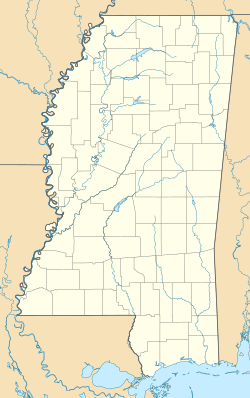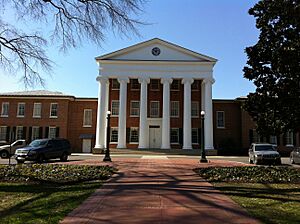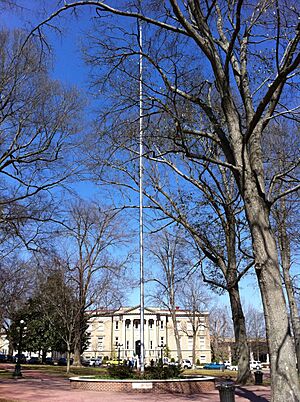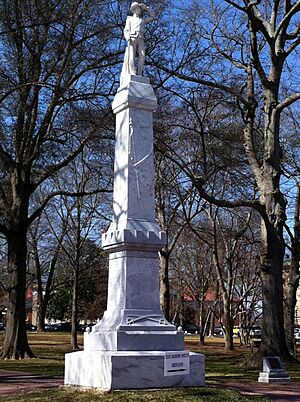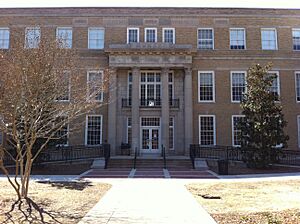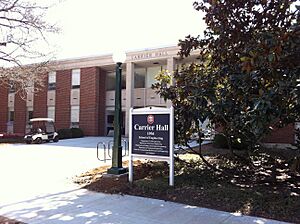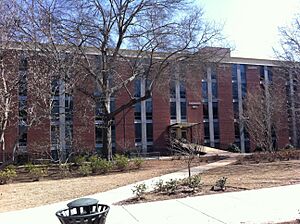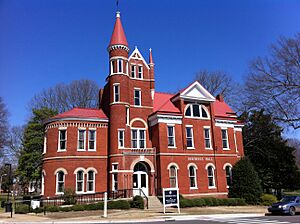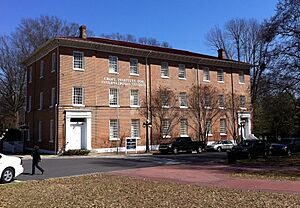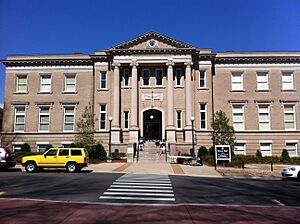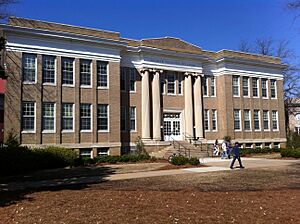Lyceum–The Circle Historic District facts for kids
|
Lyceum–The Circle Historic District
|
|
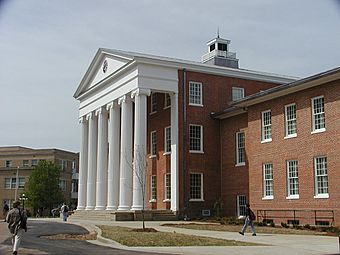
Lyceum Building
|
|
| Location | University Circle, Oxford, Mississippi |
|---|---|
| Area | 10 acres (40,000 m2) |
| Built | 1848 |
| Architect | William Nichols |
| Architectural style | Neoclassical Revival |
| NRHP reference No. | 08001092 |
Quick facts for kids Significant dates |
|
| Added to NRHP | October 7, 2008 |
| Designated NHLD | October 7, 2008 |
The Lyceum–The Circle Historic District is a special area on the University of Mississippi campus in Oxford, Mississippi. It includes eight important buildings and several monuments. These are all located around "The Circle," which is a central green space on campus. This university has been a key public school for many generations of students in Mississippi.
This historic district is also very important because of its connection to the Civil Rights Movement. This was a time when people worked to gain equal rights for all Americans. The district played a big part in the Ole Miss riot of 1962. This event showed how the United States government stepped in to protect the rights of minority groups.
The University of Mississippi was officially integrated when James H. Meredith, an African-American military veteran, enrolled on October 1, 1962. Before this, only white students were allowed to attend. In Mississippi, there was strong resistance to this court order. This led to violence on campus, which required the federal government to send help to keep people safe.
After Meredith's admission, riots broke out on campus. Both white students and people from outside the university who supported segregation gathered there. These events happened during the Civil Rights Movement, after courts had ruled that public schools must allow all races. This historic district was recognized as a U.S. National Historic Landmark on October 7, 2008.
Contents
- Exploring the Historic District
- The Lyceum Building: A Campus Landmark
- The Circle: Campus Heart
- The Flagpole: A Symbol of Change
- Confederate Monument: A Historical Marker
- University Circle: The Campus Road
- Brevard Hall: Witness to History
- Carrier Hall: A Riot Site
- Shoemaker Hall: Under Construction During Riots
- Ventress Hall: Captured in a Famous Photo
- "Y" Building: A Place of Refuge
- Bryant Hall: Center of Conflict
- Peabody Hall: A Safe Haven
Exploring the Historic District
This important district is right in the middle of the University of Mississippi campus. It features eight main academic buildings arranged around University Circle. This road surrounds a central green space called "The Circle."
The eight buildings include the Lyceum Building, Brevard Hall, the Croft Institute for International Studies (once known as the "Y" Building), and Carrier, Shoemaker, Ventress, Bryant, and Peabody dormitory halls. The district also includes the flagpole in the center of The Circle, the Confederate Monument, and University Circle itself.
The Lyceum Building: A Campus Landmark
The Lyceum Building was the first academic building at the university. In its early days, it held classrooms, faculty offices, a museum, and the library. Today, the Lyceum is used for the university's main administration offices.
Its famous front, with tall columns, is even shown on the university's official crest. The building was finished in 1848, making it the oldest on campus. It was designed by architect William Nichols.
The Circle: Campus Heart
The Circle is the central green area of the campus. It is surrounded by University Circle, a road for one-way traffic. This beautiful area has many oak and magnolia trees, colorful pansies, and wide grassy areas.
A metal flagpole stands in the middle of the green, with sidewalk paths leading from it. Since the mid-1800s, The Circle has been the main gathering spot and historic core of the Ole Miss campus.
The Flagpole: A Symbol of Change
The flagpole has been in the center of The Circle since 1962. Its base, made of brick, was added in 2000. During the famous desegregation riots, a former Ole Miss football player climbed this pole. He tried to get the rioters' attention and convince them to go home.
Confederate Monument: A Historical Marker
The Confederate Monument has been in The Circle since 1906. It features a column shaped like a castle. The monument is dedicated "To Our Confederate Dead, 1861-1865." It was placed there by the United Daughters of the Confederacy. A Confederate soldier statue stands on top, holding a rifle.
University Circle: The Campus Road
University Circle is a 50 ft (15 m) wide roundabout road. It has exits that lead to other parts of the campus. These exits are located between the "Y" Building and Bryant Hall, and on both sides of the Lyceum.
Brevard Hall: Witness to History
The Old Chemistry Building, now called Brevard Hall, was built in 1923. During the desegregation riots on September 30, 1962, students broke into this building. They threw Molotov cocktail bombs from its windows at federal and civilian vehicles parked around The Circle.
Carrier Hall: A Riot Site
Carrier Hall was one of several buildings that students entered to find materials during the 1962 riots. This building has a two-story main section and a rear section connected by covered walkways.
Shoemaker Hall: Under Construction During Riots
Four-story Shoemaker Hall was still being built during the 1962 riots. Students used construction materials from the site, like loose bricks and metal pipes, to attack federal officers. This dorm hall was sadly the location of one of the two deaths that happened during the riots.
Ventress Hall: Captured in a Famous Photo
Two-story Ventress Hall was built in 1889. It appears in a famous photograph of James Meredith walking in the graduation procession on August 18, 1963. This photo shows a key moment in the university's history.
"Y" Building: A Place of Refuge
The Croft Institute for International Studies was known as the "Y" Building during the time of desegregation. Many people found safety inside the "Y" Building to escape the tear gas and chaos during the riots. Others gathered there to watch U.S. President John F. Kennedy's televised speech about the desegregation of Ole Miss.
Bryant Hall: Center of Conflict
After serving as the university's library from 1911 to 1952, Bryant Hall has since housed departments like Fine Arts, Philosophy, Religion, and Classics. During the riots, a lot of the intense fighting between rioters and federal officers happened right in front of this hall.
Peabody Hall: A Safe Haven
During the riot, Peabody Hall offered people a safe place to escape the tear gas. While trapped inside the building, a faculty member named Russell Barrett wrote down what he saw during the riot.


